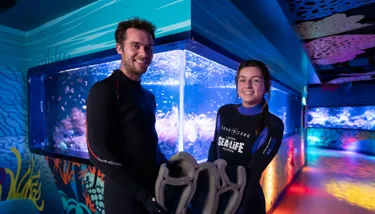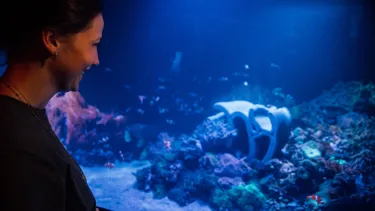The SEA-CLE of life: SEA LIFE London Aquarium partners with Resting Reef
- Tuesday 22nd July 2025

SEA LIFE London has partnered with sustainability service, Resting Reef, to install a memorial structure that encourages coral regrowth into one of its habitats, in time for Coral Awareness Week.

The 3D-printed structure was installed in the Clownfish habitat at SEA LIFE London Aquarium earlier this week in hopes to spread awareness on the importance of coral conservation, and shine light on Resting Reef’s sustainable memorial service that encourages the regrowth of marine life.
The skilled Aquarist teams at SEA LIFE London Aquarium have volunteered their valuable time and expertise to Resting Reef to support the development of these memorial coral structures that aid in habitat restoration, with an end goal to regrow whole ecosystems in our oceans.
Throughout the testing programme and partnership, SEA LIFE London Aquarium Aquarists assisted Resting Reef in careful monitoring and evaluation to ensure the unique formula was safe in waters that hosted marine life, including testing how the underwater “urns” encourage coral regrowth, which allowed Resting Reef to take the structures to their latest monitoring programme in Bali. Guests can now see one of their 3D printed prototypes themselves and see how these crucial structures work at SEA LIFE London.
Resting Reef is a pioneering memorial service that transforms human and pet ashes into reef structures that provide foundations for restoring damaged seabeds and regenerating marine ecosystems. Grounded in both science and design, their reefs provide an eternal resting place that fulfils the deep human need for remembrance, connection, and legacy, while actively supporting ocean life and coastal communities. Each memorial is carefully crafted using bio-receptive materials designed to attract marine biodiversity and rebuild habitats in areas suffering from ecological degradation.
Families receive ongoing updates on the reef’s development, fostering a lasting emotional bond with the ocean and increasing marine literacy. As a sustainable business model, Resting Reef engage families to be personally invested and channels funding into the critically underfunded marine restoration sector, offering a regenerative and meaningful alternative to traditional memorials.
Following successful pilot placements in Tianyar Bay and Tulamben Village in North Bali, areas historically damaged by coral mining and unsustainable fishing, the memorial reefs have reported up to 14 times more biodiversity and the presence of 84 distinct fish species compared to nearby degraded sites. Now expanding to the UK and beyond, Resting Reef’s vision is to make memorial reefs as culturally accepted and accessible as cemeteries, turning personal loss into a living legacy that gives back to the planet.
Speaking about the partnership, Matthew Bradshaw, Assistant Curator at SEA LIFE London Aquarium, says, “It has been a pleasure offering our expertise to support this incredible conservation project, and even more of an honour to have a prototype structure here on display at SEA LIFE London Aquarium. We hope this will raise awareness on the importance of coral conservation, and encourage more sustainable behaviours. We hope that this will be a long-term partnership and hope to send some of Aquarists out to Bali to help contribute further to the incredible habitat restoration work Resting Reef are doing.”.
Louise Skajem, Cofounder and Head of Sustainability and Product at Resting Reef, adds, “We are so grateful for SEA LIFE London Aquarium’s ongoing support, particularly during the formula-testing phases to ensure our structures were safe for installation in the wild. They have provided us with expert advice and guidance along the way and it has been a pleasure working alongside them from structure design, to now being placed on the sea-beds. We look forward to continuing this partnership and continuing to raise awareness on coral conservation together.”